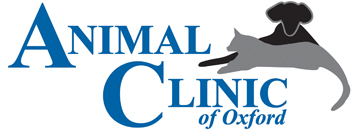Radiography is a valuable diagnostic tool in veterinary medicine. As we continually strive to offer the highest quality medicine and diagnostic testing, we are pleased to offer radiology services as a means of providing excellent care to our patients.
A radiograph (sometimes called an x-ray) is a type of photograph that can look inside the body and reveal information that may not be discernable from the outside. Radiography can be used to evaluate almost any organ in the body, including the heart, lungs, and abdominal organs, as well as the bones.
Radiography is painless, safe, and completely non-invasive, and it uses only very low doses of radiation. Because the level of radiation exposure needed to perform radiography is very low, even pregnant females and very young pets can undergo radiography. Radiographs can be used to evaluate bones as well as the size, shape, and position of many of the body’s organs. The size of organs is important because some medical conditions—such as kidney, heart, or liver disease—can alter the size of these organs. The shape and position of organs can be altered or distorted by certain medical conditions, including intestinal blockage or cancer. Tumors, depending on their size and location, can also sometimes be detected using radiography. Radiography can also be used to diagnose bladder stones, broken bones, chronic arthritis, certain spinal cord diseases, and a variety of other conditions.
Radiographs are an important tool that can help us make a correct diagnosis for your pet. We are able to provide digital radiographs for evaluation and submission to the Orthopedic Foundation for Animals (OFA). We utilize the services of board certified veterinary radiologists for cases that require special attention.
Veterinary diagnostic imaging is used to discover internal disease or injury. Animal Clinic of Oxford employs advanced imaging technologies operated by board-certified veterinary radiologists, guaranteeing the highest quality of care for our patients.
Radiographs, or X-rays, use electromagnetic radiation directed towards the body to highlight objects within. They can detect abnormalities including skeletal fractures, soft tissue damage, foreign bodies and dental disease.
Animal Clinic of Oxford Radiology Services
- Radiographs
- Ultrasounds
- Computed Tomography (CT)
- Magnetic Resonance Images (MRI)
- [CUSTOMIZE LIST PER HOSPITAL]
Orthopedic radiographs and contrast studies require the patient remain completely still to work correctly, necessitating sedation in most cases. Some specialized procedures may require anesthesia. The duration of sedation or anesthesia is usually short and patient recovery is swift. A board-certified anesthesiologist oversees all procedures.
To make a radiology consultation or appointment for your pet, call us at (662) 234-8022.
Explore Our Complete List of Veterinary Services in Oxford, MS
- Reproductive Services
- Puppy and Kitten Care
- Pain Management
- Hospice and Euthanasia Services
- Emergency and Critical Care
- Bathing
- Laboratory
- Fully Stocked Pharmacy
- Anesthesia
- Vaccinations
- Parasite Prevention
- Wellness Exams
- Behavioral Medicine
- Dental Care
- Nutritional Counseling
- Surgery
- Boarding
- Senior Wellness
- Microchipping
- Pet Emergency
- Ultrasound
What's Next
Call us or schedule an appointment online!
Meet with a doctor for an initial exam.
Put a plan together for your pet.

